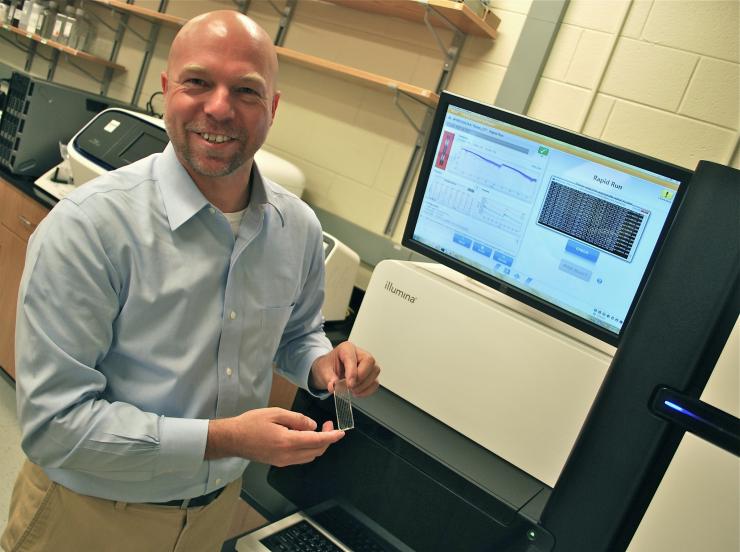New sequencing machine in Vannberg lab speeds up the pace of research and analysis.
It took a global community of scientists more than 10 years and almost $3 billion to sequence the first complete human genome. That was in 2003. Today, Georgia Institute of Technology scientist Fred Vannberg can do it in a day, at a microscopic fraction of the cost, thanks to a new piece of equipment in his lab, and his own expertise in genetic statistics.
“We’re plowing away and helping whomever needs sequencing right now,” says Vannberg, indicating the HiSeq 2500 System, a next-generation sequencing machine that is helping to revolutionize genomic research. “The idea is to give researchers direct access to this kind of technology. So, instead of waiting six to seven weeks for a single set of experiments, we can have it done within a week. Or, if they have samples ready, we can load it and have the data the next day.”
Slated to become part of the vast and growing Core Facilities at the Parker H. Petit Institute for Bioengineering and Bioscience, the HiSeq 2500 (made by Illumina) already is getting a workout from researchers and institutions across the spectrum, including the Centers for Disease Control and Prevention in Atlanta, and John McDonald, professor in the School of Biology and director of the Integrated Cancer Research Center.
McDonald says the combination of the high-throughput sequencer with Vannberg at the helm is a win-win for Georgia Tech and the wider research community. Vannberg, assistant professor in the School of Biology, joined Georgia Tech in 2011, following a stint as director of the sequencing program at the Dana Farber Cancer Center at Harvard.
“We are fortunate to not only have a state of the art sequencing platform at Georgia Tech but to have a skilled and experienced individual such as Fred to oversee the facility,” says McDonald.
There are plenty of companies offering sequencing services, McDonald says, but typicallly the turnaround time, “is simply too long for most research applications, so having our own in-house facility, where the turnaround time is a few days, is absolutely essential for most research applications.”
McDonald’s research team is using the HiSeq 2500 to develop (in collaboration with Vannberg and King Jordan (associate professor in the School of Biology, and director of the Bioinformatics Graduate Program) algorithms to predict optimal personalized drug therapies, based on the genomic profiles of individual patient tumors. “Rapid genomic profiling – DNA and RNA sequencing – of patient samples is critical to this program,” McDonald adds.
Georgia Tech got its new machine through the largesse of the Georgia Research Alliance (GRA), who funded the $803,000 sequencer. It’s part of an ongoing effort to bring world-class research talent and capacity to the state, says GRA senior vice president Susan Shows, who heads up the alliance’s investment portfolio, which includes the award-winning Eminent Scholars Program and more than $600 million of strategic research infrastructure at Georgia's six leading research universities.
“GRA can make a huge difference in helping to outfit labs, which allows our universities to be more competitive,” Shows says. “A tool like this sequencer is something that no one faculty member can use full time, so we’re trying to help universities create these core facilities so that everyone gets their money’s worth. And this sequencer may open the door to grants that researchers haven’t been able to go after before.”
Vannberg’s lab is already operating kind of like a core facility, attracting a broad cross-section of research disciplines. For example, on this day, Vannberg is reading DNA from a child patient, “trying to understand the ecology of what’s going on in the lung.” The night before, it was a tumor sample from a patient with ovarian cancer. Vannberg and his research team also are developing software to analyze the resulting data, which is really huge – 350 million sequence reads from DNA in that child’s lung, for instance.
Meanwhile, the details that will result in the HiSeq 2500 becoming part of core facilities are still being finalized, according Steve Woodard, manager of the Petit Institute core facilities.
“It’s definitely being used as a shared resource from a variety of people in different disciplines,” says Woodard, who is genuinely thrilled by the research potential of the HiSeq 2500. “It brings us closer to understanding why one person gets a disease and another person does not. So, it’s helping to facilitate the dawn of individualized medicine.”


Jerry GrilloCommunications Officer IIParker H. Petit Institute for Bioengineering & Bioscience
